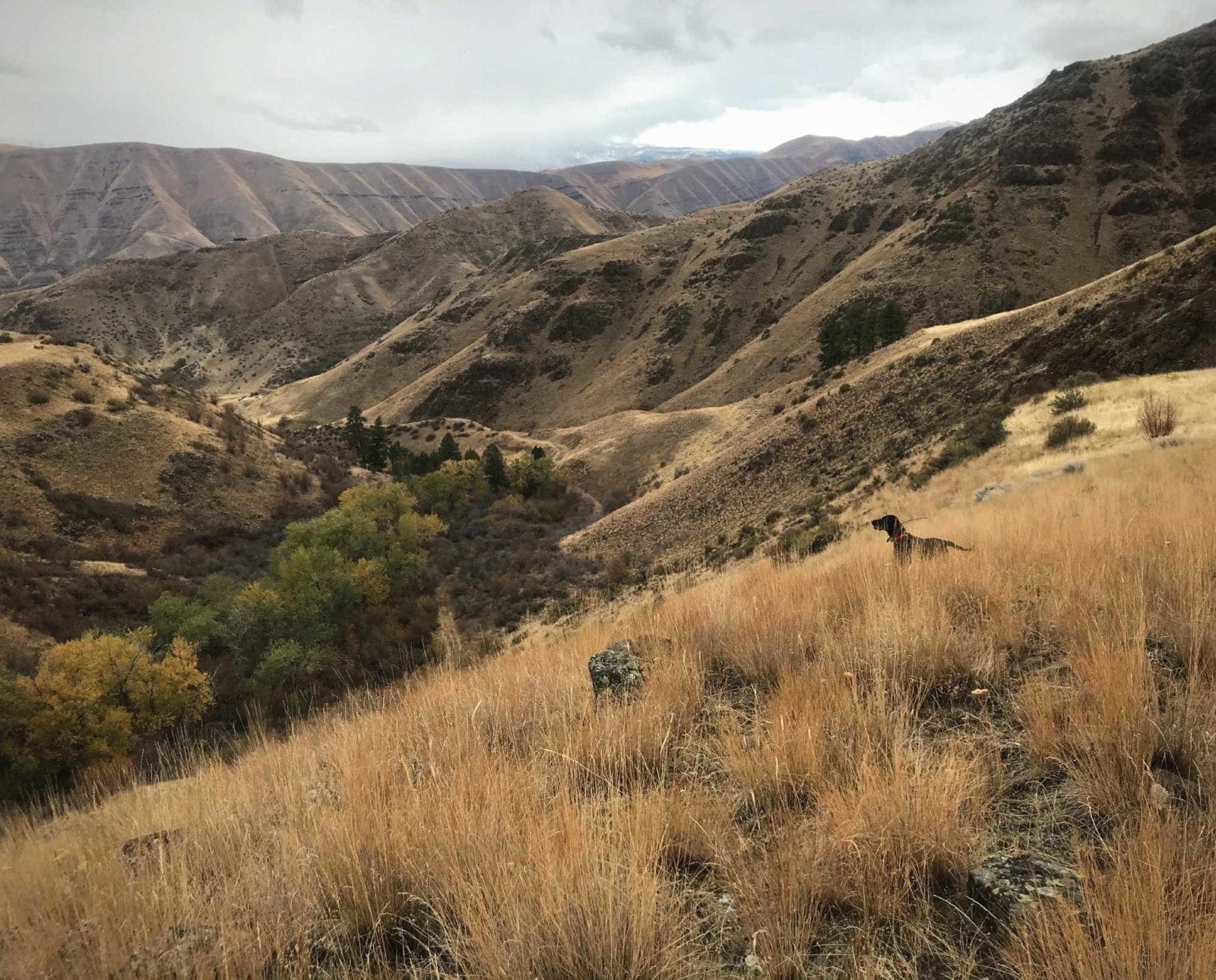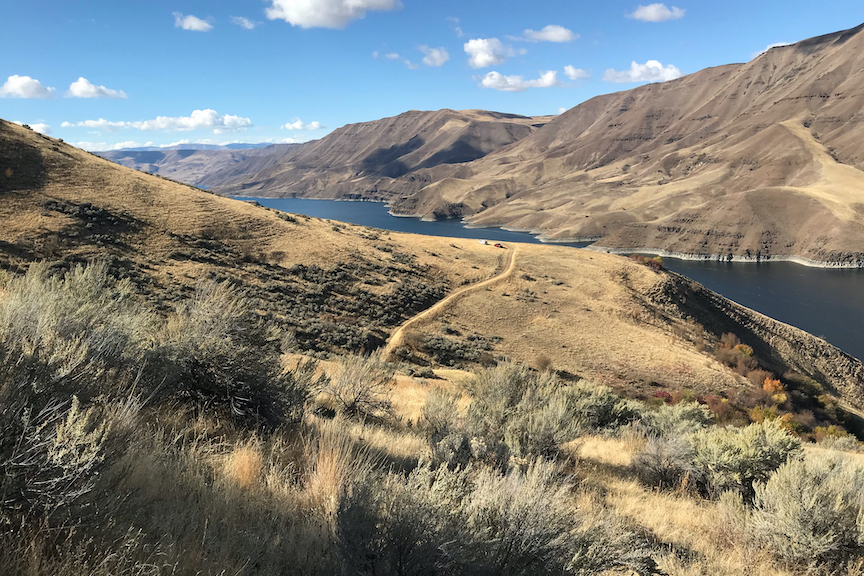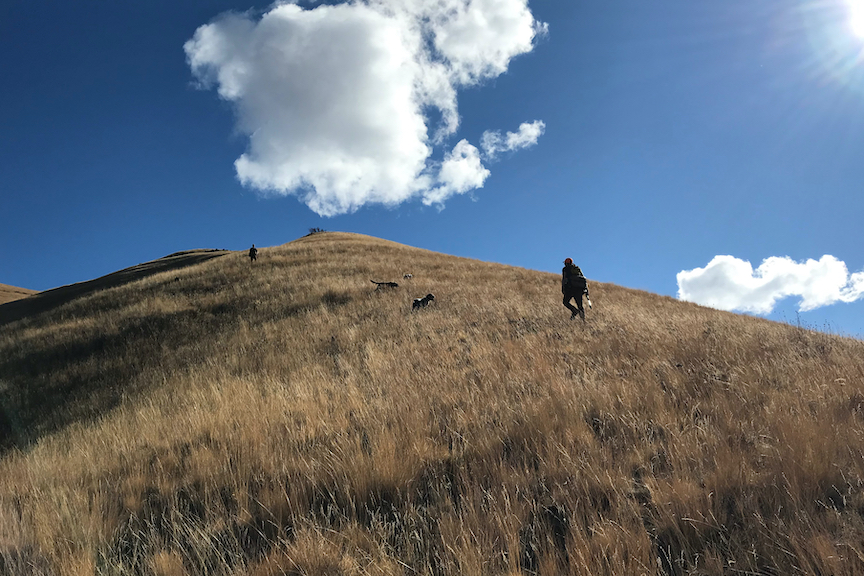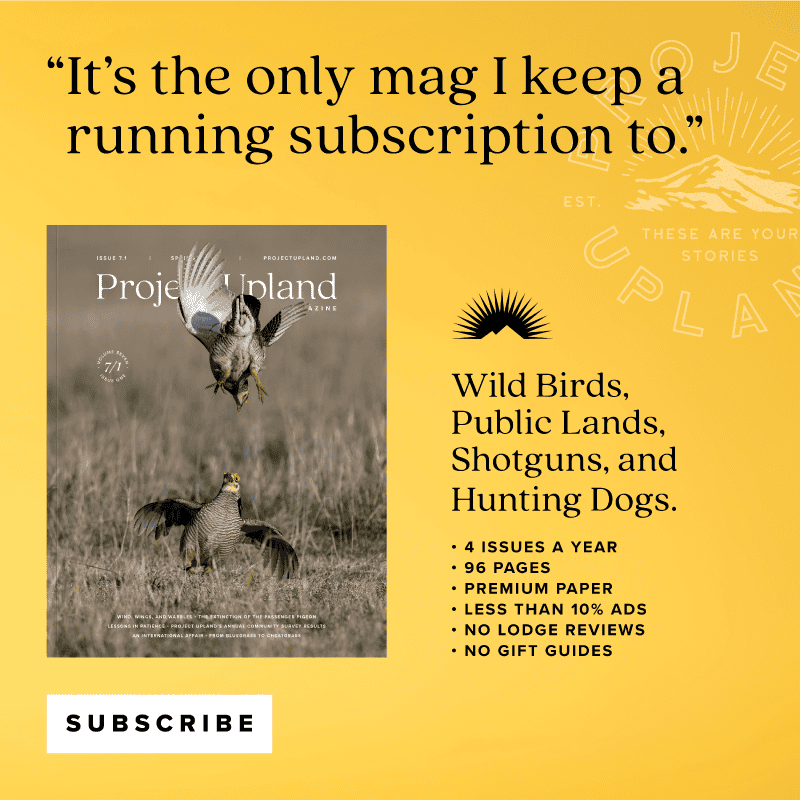Home » Public Lands » A Beginner’s Guide to Hells Canyon
A Beginner’s Guide to Hells Canyon

Jennifer Wapenski is the Director of Operations and Managing Partner…
Tips for making the most of your first hunting trip to this iconic chukar destination
The sound of wingbeats snapped me out of my daydream and back to the present. My aching legs welcomed the sudden pause as I looked around for the source of the sound. There, in the distance, a frustrating 500 feet above us, a little cluster of black dots disappeared over the ridge. I muttered my opinion of the birds under my breath before we continued climbing.
Hells Canyon is legendary. The deepest river gorge in North America, which translates to the highest river-gorge-sides-to-climb-in-search-of-birds in North America, it is the stuff from which upland hunting dreams are made. You’ve seen the Instagram photos and the YouTube videos: smiling hunters and stacks of chukar against a stunning backdrop of plunging canyon and endless cheatgrass. Dogs roam the inclines and ease into staunch points to indicate coveys hidden by ridges and rocky outcroppings. Bird hunting paradise is neatly packaged into a few iconic images or a couple minutes of film.
It is a paradise, yes. Public land stretches as far as the eye can see. Stunning views in every direction reward the hard work of the climb. Especially for those unaccustomed to the West’s vast public land hunting opportunities, the sheer scale of the area is mind-boggling. But it’s that sheer scale that truly earns the moniker Hells Canyon and not Heavens Canyon. It is no easy task to hunt Hells Canyon and the birds are by no means guaranteed.
My first trip to Hells Canyon was not successful in the traditional sense of the word. The canyon did not give up her birds for us, despite a fair number of encounters and sightings. We were hampered by strong winds, jumpy birds, and the rookie disadvantage of not really knowing how to work birds on a landscape of this scale. Yet despite coming home empty-handed, we came home full of memories of fine dog work, memorable firsts for the young pup, the camaraderie of new friends, and the soul-satisfying sense of accomplishment in scaling those canyon walls.
For the uninitiated, a healthy dose of preparation—both mental and physical—will go a long way toward making the most of your efforts. Going to Hells Canyon once does not make anyone an expert. If anything, it just exposes how little you actually know about how to hunt this canyon. It is from that humble perspective that I offer a few tips to anyone considering a first-time hunt here.
Prioritize the health and fitness of your dogs
Arguably the most important thing you can do to prepare for a trip to Hells Canyon is to ensure that your dog(s) are in excellent physical shape. The steep hills, dry ground, variable weather, and long distances can take a toll on even the fittest of dogs.
Your own fitness is important as well, of course, but we humans are better at listening and responding to our bodies than our dogs are. After all, we’ve selectively bred hunting dogs for hundreds of years to have more and more drive, which means less and less willingness to stop if they are tired or injured. Make sure your dog has been properly exercising and training for the physical demands you can expect to encounter while hiking and hunting in steep, rocky terrain.
The importance of foot care cannot be overstated, either. Make sure your dog has plenty of exposure to dry, rough ground before embarking on a multi-day trip to Hells Canyon. The last thing you want is for a pad injury to sideline your dog and derail your multi-day hunt. If you plan to use boots, make sure your dog has experience with them before they are needed in the field.
Have a plan ahead of time for where you’ll focus your efforts
Hells Canyon is big. The National Recreation Area alone encompasses over 650,000 acres and road access is pretty limited. In other words, don’t expect to be able to scout large sections of the canyon and make your plan once you arrive. Do some research ahead of time, call the state biologists to see what they’re hearing about bird numbers, and talk to others who have been there recently.
Like the other western states, wildfires are an annual occurrence in this area. Be aware of recent fire activity and be prepared to adjust your plans if your intended destination has recently burned.

Watch the time zones, especially with a group of hunters
A subtle but potentially inconvenient detail is that Hells Canyon straddles both Mountain and Pacific time zones. Due to the lack of cell service in most areas of the canyon, your cell phone will likely not update with the correct time to match where you stand. Worse, when you do have service, it’s possible to unknowingly connect with a tower on the other side of the imaginary line.
If you’re making plans to meet up with a group, make sure you all agree on your working time zone for the trip and set a watch or other non-connected device to help prevent confusion.
While on the subject of boundary lines, don’t forget that Hells Canyon also straddles the Idaho/Oregon state line. This one is harder to miss because you’ll surely notice if you cross the river into the other state, but be aware of different licensing requirements and hunting regulations depending upon which section of the canyon you intend to hunt.
Don’t be afraid to give up elevation in exchange for birds
I lost count of the number of times that a dog would go on point somewhere well below us on the slope. It’s disheartening to give up hard-won elevation to go investigate a birdy dog or a point, knowing full well that you’ll have to repeat the climb that is currently pounding in your chest. But remember, chances at birds are probably going to be hard to come by. Don’t ignore a likely bird encounter in the hopes of finding another covey that’s easier to reach. You worked hard to get here, so don’t give up now.
Speaking of elevation, it’s sort of cliché advice but do pay attention to the elevations at which you find coveys of chukar. The circumstances that lead a covey of birds to be in a particular location likely apply to all the birds in the area. If you find them along a particular elevation line, there’s a very good chance that you’ll find additional birds at that same level.

Think outside the chukar box
Hells Canyon is obviously an iconic destination for chukar hunting, but the area also offers countless opportunities for other bird species. Don’t ignore the huns on the lower benches, the valley quail and ruffed grouse in the aspen-choked stream beds, the blue grouse in the conifer forests, or even the turkeys in the valleys! The incredible diversity of this area means that there is a wide variety of habitat and therefore a wide variety of hunting opportunities.
As a word of caution, make sure you know how to identify mountain quail and sage grouse and be prepared to make that identification on the wing should you flush either of these species in an area where they are protected from hunting.
Don’t be shy about adjusting your expectations of success
The highlight reel that is social media can create unrealistic expectations for your first trip to Hells Canyon. If you’re anything like me, it’s best to be honest with yourself ahead of time about what you want to achieve and what will make you feel like the trip was a success.
If you want a guarantee of birds in the bag, go somewhere else. If you want a guarantee of heart-pounding effort, jaw-dropping vistas, and the kind of type two fun that only gets sweeter with hindsight and tales shared over beers, then absolutely make plans to give Hells Canyon a try.
Jennifer Wapenski is the Director of Operations and Managing Partner at Project Upland Media Group. She has a lifelong passion for the outdoors, dogs, and wildlife; as an adult, she discovered that upland bird and waterfowl hunting were natural extensions of these interests. What started as initial curiosity soon escalated into a life-changing pursuit of conservation, advocacy, and education. Jennifer serves in a variety of roles such as the Breed Warden for the Deutsch Langhaar—Gruppe Nordamerika breed club and on an advisory committee for the Washington Department of Fish and Wildlife.





